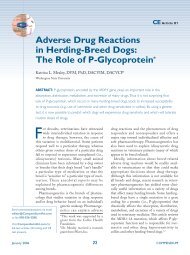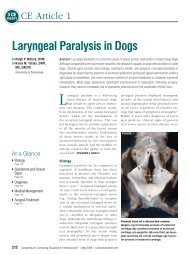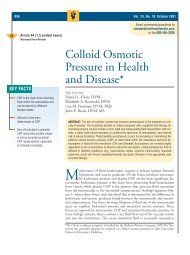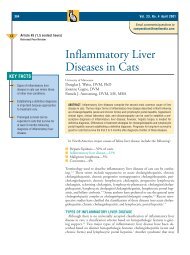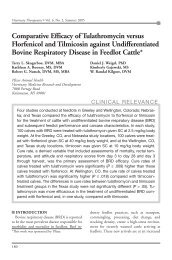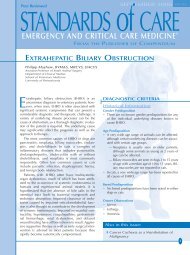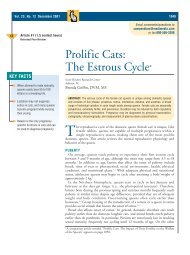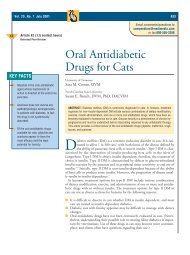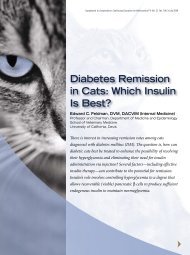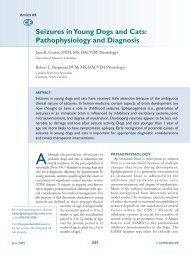You also want an ePaper? Increase the reach of your titles
YUMPU automatically turns print PDFs into web optimized ePapers that Google loves.
464 Small Animal/Exotics Compendium June 2002<br />
pressed patients. Choosing the proper antibiotic therapy should be based on<br />
the known sensitivity of the antibiotic to the normal bacterial flora of the GI<br />
tract or the specific bacterial pathogen, if known. Stomach microflora has a<br />
transient population of clostridia, streptococci, lactobacilli, E. coli, and spirochetes.<br />
33 The proximal small in<strong>test</strong>inal bowel has low numbers of gram-positive<br />
bacteria, including streptococci and lactobacilli. Anaerobes and gram-negative<br />
bacteria are the predominate organisms in the distal small in<strong>test</strong>inal<br />
bowel and colon, with over 90% of anaerobic bacteria (i.e., Bacteroides,<br />
clostridia, lactobacilli) <strong>com</strong>prising the colonic environment. 33 Other considerations<br />
when choosing an antibiotic include using a bactericidal drug for severe<br />
hemorrhagic diarrhea or for immunosuppressed patients; using drugs that can<br />
be given by parenteral route in patients that are vomiting, septic, or unconscious;<br />
choosing an antibiotic based on culture and sensitivity results when<br />
available; and being aware of toxic side effects (e.g., nephrotoxicity of an<br />
aminoglycoside in dehydrated animals).<br />
IMMUNE-MODULATING DRUGS<br />
Inflammatory or immune-mediated diseases of the bowel are treated by<br />
immunosuppressive therapy. In dogs and cats, IBD is the most <strong>com</strong>monly diagnosed<br />
disease by endoscopic biopsy or surgical biopsy of the GI tract. Treatment<br />
is directed at reducing the inflammation and implementing a controlled diet<br />
(Table 8). 34–36 Drugs that can effectively help decrease the inflammatory response<br />
in the GI tract are metronidazole, salicylates, prednisone, azathioprine, cyclophosphamide,<br />
chlorambucil, and potentially cyclosporine. 36 Tylosin, a macrolide-like<br />
antibiotic used for bacterial overgrowth, has also been reported to be effective in<br />
some patients with IBD, although the exact mechanism of action is unknown. 36 It<br />
is available in a powder and can be sprinkled on the animal’s food.<br />
Metronidazole<br />
Metronidazole is an antibiotic with sensitivity to anaerobic bacteria, although it<br />
does not cause detrimental alteration of normal bacterial flora. It also has immunemodulating<br />
properties that suppress <strong>ce</strong>ll-mediated responses, is an antiprotozoal,<br />
and has positive effects on brush-border enzyme levels and the uptake of nutrients<br />
by the in<strong>test</strong>ine (e.g., glucose, amino acids). 37 It is unknown which of its actions is<br />
responsible for its efficacy in treating IBD. Metronidazole can be effective in mild<br />
cases of IBD and provide good control. In moderate to severe cases, it can be used<br />
as a <strong>com</strong>bination therapy with lower doses of prednisone.<br />
Salicylates<br />
Sulfasalazine, a salicylate, is used specifically for inflammation of the colon<br />
and is the treatment of choi<strong>ce</strong> for chronic colitis. This drug contains sulfapyridine<br />
and 5-aminosalicylate joined by an azo bond that is separated in the colon.<br />
The 5-aminosalicylate <strong>com</strong>ponent, which acts as a local suppressor of inflammation,<br />
is an NSAID that inhibits cyclooxygenase and lipoxygenase activity<br />
inhibiting prostaglandin and leukotriene synthesis. In mild to moderate cases of<br />
colonic IBD, this drug can be beneficial when used alone. In more severe cases,<br />
this drug should be used in <strong>com</strong>bination with metronidazole or prednisone.<br />
Side effects include anorexia, vomiting, diarrhea, and keratoconjunctivitis sicca<br />
(which can lead to corneal ul<strong>ce</strong>ration); in cats, anemia has been reported.<br />
Preparations of 5-aminosalicylate without the sulfapyridine <strong>com</strong>ponent<br />
(mesalamine, olsalazine) may prevent keratoconjunctivitis sicca and are <strong>com</strong>monly<br />
used in human medicine for long-term treatment. 38 However,<br />
mesalamine may decrease tear production in dogs.



